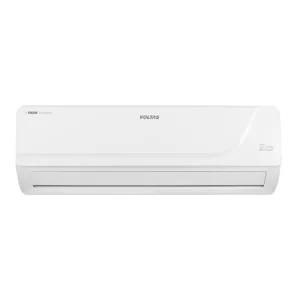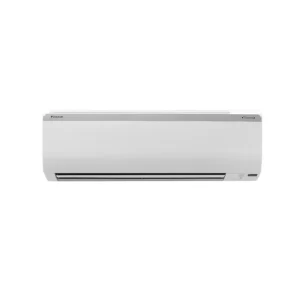Split AC
-
Godrej 2 Ton 3 Star, 5-In-1 Convertible Cooling, Inverter Split AC
Capacity 2 Tons Cooling Power 6.05 Kilowatts Special Feature 5-in-1 Convertible Technology with inverter compressor, I Sense Technology,100% Copper Condenser, Evaporator Coils & Connecting Tube, R32 Refrigerant, Remote Control, Anti-Freeze Thermostat, Silent Operation, Anti Dust Filter ₹46,999.00 -
Samsung 1.5 Ton 5 Star Inverter Split AC
Capacity 1.5 Tons Cooling Power 5.8 Kilowatts Special Feature Copper Anti-bacterial Filter, Auto Clean (Self Cleaning) ₹48,749.00Samsung 1.5 Ton 5 Star Inverter Split AC
₹48,749.00 -
Voltas 1.4 Ton 3 Star Inverter Split AC
Capacity 1.4 Tons Cooling Power 1.5 Kilowatts Special Feature Remote Controlled, Dust Filter ₹34,374.00Voltas 1.4 Ton 3 Star Inverter Split AC
₹34,374.00 -
Daikin 1 Ton 3 Star Fixed Speed Split AC
Capacity 1 Tons Cooling Power 3.35 Kilowatts Special Feature High Ambient Operation upto 50°C, Good sleep off timer, PM 2.5 Filter, Dust Filter, Self Diagnosis, Air Purification Filter, Dehumidifier, Fast Cooling ₹33,249.00Daikin 1 Ton 3 Star Fixed Speed Split AC
₹33,249.00 -
Lloyd 1.5 Ton 5 Star Inverter Split AC, 5 in 1 Convertible, 100% Copper
Capacity 1.5 Tons Cooling Power 5.1 Kilowatts Special Feature Golden Fin Evaporator; Anti-Viral Filter + PM 2.5 Filter, Low Gas Detection; Clean Filter Indication, Smart 4 Way Swing; Rapid Cooling (18°C in 45 seconds); Turbo Cool; 100% Copper, Installation Check; Stabilizer Free Operation; Hidden LED Display, 5 in 1 Convertible; Cools Even @ 52 ˚C; ₹43,613.00 -
Lloyd 1.0 Ton 3 Star Inverter Split AC, 5 in 1 Convertible, Copper
Capacity 1 Tons Cooling Power 3.55 Kilowatts Special Feature Golden Fin Evaporator; Anti-Viral Filter + PM 2.5 Filter, 5 in 1 Convertible; Cools Even @ 52 ˚C, Low Gas Detection; Clean Filter Indication, Installation Check; Stabilizer Free Operation; Hidden LED Display, Turbo Cool; 100% Copper ₹32,113.00 -
Daikin 1.5 Ton 3 Star Inverter Split AC
Capacity 1.5 Tons Cooling Power 17100 British Thermal Units Special Feature High Ambient Operation upto 52°C, 3D Airflow, Dew Clean Technology, Triple Display, PM 2.5 Filter ₹40,613.00Daikin 1.5 Ton 3 Star Inverter Split AC
₹40,613.00 -
Voltas 2 Ton 3 Star, Inverter Split AC, Copper, 243V Vectra Elite, White
Capacity 2 Tons Cooling Power 2 Kilowatts Special Feature Remote Controlled, Dust Filter ₹48,488.00
Comprehensive Guide to Split Air Conditioners (AC)
Introduction
In today’s world, maintaining a comfortable indoor environment is essential, particularly during hot summer months. Split air conditioners (ACs) have become a popular choice for homeowners and businesses alike due to their efficiency, versatility, and ease of installation. This guide provides an in-depth look at split ACs, including their features, benefits, types, installation process, maintenance tips, and frequently asked questions (FAQs). This comprehensive content aims to enhance your understanding of split ACs and assist you in making informed purchasing decisions.
What is a Split Air Conditioner?
A split air conditioner consists of two main components: an indoor unit and an outdoor unit. The indoor unit is responsible for cooling the air inside the room, while the outdoor unit houses the compressor and condenser. This design allows for quieter operation indoors and more efficient cooling.
Key Components of a Split AC
- Indoor Unit: Contains the evaporator coil and fan. It circulates cool air into the room.
- Outdoor Unit: Houses the compressor and condenser coil. It expels heat absorbed from the indoor air.
- Refrigerant Lines: Connect the indoor and outdoor units, allowing refrigerant to flow between them.
- Thermostat: Regulates the temperature settings according to user preferences.
Benefits of Split Air Conditioners
- Energy Efficiency: Split ACs are known for their energy efficiency compared to traditional window units. They often come with high Energy Efficiency Ratings (EER), which can lead to lower electricity bills.
- Quiet Operation: Since the compressor is located outside, split ACs operate much quieter than window units, making them ideal for bedrooms and offices.
- Flexible Installation: Split ACs can be installed in various configurations, allowing homeowners to choose the best placement for optimal airflow.
- Aesthetic Appeal: The sleek design of split ACs blends well with modern interiors, enhancing the overall look of a room without obstructing views.
- Zone Cooling: Many split systems allow for multiple indoor units connected to one outdoor unit, enabling zone cooling where different rooms can be set to different temperatures.
Types of Split Air Conditioners
Split air conditioners come in several types, each designed to meet specific cooling needs:
- Wall-Mounted Split AC: The most common type, these units are mounted on walls and are suitable for small to medium-sized rooms.
- Cassette Split AC: Installed in ceilings, these units distribute air evenly across a room and are ideal for commercial spaces or larger rooms.
- Ducted Split AC: These systems use ducts to distribute cool air throughout multiple rooms, providing centralized cooling.
- Multi-Split AC: This type connects multiple indoor units to a single outdoor unit, allowing for independent temperature control in different rooms.
- Portable Split AC: These units are mobile and can be moved from room to room as needed.
Maintenance Tips for Split Air Conditioners
Regular maintenance is key to ensuring your split AC operates efficiently:
- Clean or Replace Filters Regularly: Dirty filters can restrict airflow and reduce efficiency. Clean or replace them every month during peak usage seasons.
- Check Refrigerant Levels: Low refrigerant levels can indicate leaks; have a professional check levels annually.
- Clean Coils: Both indoor and outdoor coils should be cleaned periodically to remove dust and debris that can hinder performance.
- Inspect Drain Lines: Ensure drain lines are clear to prevent water buildup that can cause mold growth or system damage.
- Schedule Professional Servicing: Have your system professionally serviced at least once a year for thorough cleaning and inspection.
Frequently Asked Questions (FAQs)
1. How do I choose the right size split AC for my room?
Choosing the right size involves calculating the British Thermal Units (BTUs) needed based on your room’s square footage, ceiling height, insulation quality, and sun exposure. A general rule is that you need about 20 BTUs per square foot of living space.
2. What is the average lifespan of a split AC?
A well-maintained split air conditioner typically lasts between 12 to 15 years. Regular maintenance can extend its lifespan significantly.
3. Are split ACs energy-efficient?
Yes, split ACs are generally more energy-efficient than traditional window units due to their inverter technology and higher EER ratings.
4. Can I install a split AC myself?
While DIY installation is possible for those with technical skills, it is recommended to hire a professional for proper installation to avoid voiding warranties or damaging equipment.
5. What should I do if my split AC is not cooling effectively?
Check if filters are clean, ensure windows are closed tightly, inspect refrigerant levels, or contact a professional technician if problems persist.
6. How often should I service my split AC?
It is advisable to service your split AC at least once a year before peak usage seasons begin.
7. Can I use a split AC in multiple rooms?
Yes! Multi-split systems allow you to connect several indoor units to one outdoor unit, providing efficient cooling across multiple rooms with independent temperature control.
Conclusion
Split air conditioners offer an excellent solution for efficient cooling in various environments, from homes to commercial spaces. Understanding their features, benefits, installation processes, maintenance requirements, and addressing common questions can empower consumers in making informed decisions when purchasing an air conditioning system. Investing in a quality split AC not only enhances comfort but also contributes positively towards energy savings over time.By following this comprehensive guide on split air conditioners, you can ensure that you choose the right product that meets your specific needs while enjoying all its benefits efficiently and effectively.








